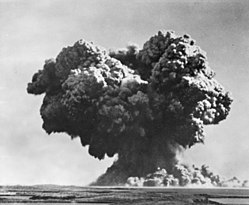HMS Plym (K271)
HMS Plym (K271) was a River-class frigate that served in the Royal Navy between 1943 and 1952. The ship was destroyed in the United Kingdom's first nuclear weapon test, Operation Hurricane in 1952. ConstructionPlym was built to the Royal Navy's specifications as a Group II River-class frigate. She was laid down by Smiths Dock Co. at their yard in South Bank-on-Tees on 1 August 1942 and launched on 4 February 1943. She was commissioned into the Royal Navy on 16 May 1943 as HMS Plym (K271) and was named after the River Plym in Devon, England which flows into the English Channel at Plymouth. Service historyPlym saw extensive service on Atlantic convoy escort missions. Plym, along with HMS Bann, HMS Teviot and HMS Trent, provided anti-submarine escort to the convoy WS-33 which arrived in South Africa from the United Kingdom on 9 October 1943 with critical reinforcements for service in Burma. Operation HurricanePlym was used as the detonation platform for the UK's first nuclear weapon in Operation Hurricane. A 25-kiloton atom bomb was detonated a few seconds before 09:30 local time on 3 October 1952 approximately 400 metres (440 yd) from the island of Trimouille in the Monte Bello Islands, Western Australia.  Although data acquisition would have been simplified by detonating the bomb from a tower above the ground or sea surface, it was conducted aboard Plym in order to simulate the effects of a nuclear weapon being smuggled into a British harbour aboard a ship. References
|
||||||||||||||||||||||||||||||||||||||||||||||||||














